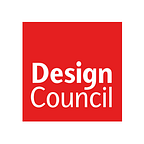Challenging the brief: Tackling the climate crisis through design
When we hear the word ‘design’ we typically think of the delivery of a tangible product, service or building. But for us at Design Council, design is more than a path to delivery: it’s a facilitator of systemic change, influencing our communities, nature and politics.
What is systemic design?
An approach that tackles complex problems by considering all the interconnected parts of a system.
This method challenges users to radically reimagine and create new ways of living. It provides the skills and structures for further ideas to grow.
How can systemic design tackle climate change?
There is a huge role for designers to play in the green transition to a more circular, sustainable and regenerative world. Did you know that:
- 47% of all plastic waste comes from packaging (Waste Age, Design Museum)
- 80% of the environmental impact of any new product is determined at the design stage (European Commission, 2012)
- 60% of emissions reductions needed by 2035 will require societal and behavioural changes (Committee for Climate Change)
These statistics are overwhelming. The climate crisis is all-encompassing, rooted in ingrained beliefs and behaviours, and includes people, nature, government, organisations. Beyond creating more sustainable products, we need a radical reimagination of how we, as a society, behave, live and consume.
Where do I start?
For those who are at the start of this practice, we’ve listed a few practical shifts to start implementing systems thinking into your design practice.
1. From competition to collaboration
Designers already have a great understanding of how to design for people, and Human-Centred Design is at the heart of design thinking. What perhaps doesn’t happen as much, is working with and for the collective: neighbourhoods, societies, ecological systems, rather than isolated individuals. There is a need to recognise that no-one has the complete picture of the system: we therefore need to include multiple perspectives and bring marginalised voices into the design process.
Future Vision and Different Perspectives
2. From thinking about consumers to thinking about nature as your key stakeholder
When designing systemically, you need to consider who else is impacted by your designs. Considering the spillover effects of your designs allows you to break or address this cycle. As designers, we need to ask the right questions — critical questions — and be aware of how different perspectives influence decisions. But also be aware of which voices are not included.
Stakeholder Ecosystem and Unintended Consequences
3. From creating products to creating radical visions
Recent graduates will recognise the disparity between university, where you set the brief, and practice, where you are responding to a brief. It’s important to continue to be curious on how you might expand and shape the brief for the results to become more ambitious and impactful. Instead of isolating a problem and seeing it as something to be fixed, we can start viewing it as a product of a wider set of system dynamics. Expand the brief, recognising the interrelatedness of different parts of a system and the relationships between them.
4. From reacting to policy to influencing policy
This has possibly one of the most untapped potential. How can our designs start to enable policy shifts to set new standards? For this to happen, commissioners need to firstly understand the role of design in the green transition, and then actually commission it. But designers can play a role in facilitating this change by taking on more strategic and leadership roles — you might see it as expanding your existing (material) language to include softer skills such as influencing and storytelling.
5. From financial value to holistic value
To tackle an issue as big as the climate crisis, we need to move from business models that are dependent on profits to regenerative business models. How are the products and services adding value for people; how is it supporting biodiversity? Designers will need to understand the implications for business, but on the other hand we need business to understand the value and implications of design for their business.
Systemic design in practice
Innovation is key to tackling the climate crisis. We are already seeing amazing innovations in products and services that are shifting narratives and behaviours. However, a sole focus on innovation can bring unintended consequences that we may not have anticipated when looking at a product or intervention in isolation. Consider the advancement of electric cars. Their use is growing exponentially with an expectation that at least 50% of new car sales in the UK will be electric. That raises questions around some of the negative effects of electric car productions, and how these will be mitigated when the use of electric cars is scaled up across the world. Think about the ethics of battery production, fuelling abuse in Congo, or the energy sources used to charge them.
How can we avoid these unintended consequences?
By zooming in and out, and utilising partnerships to bring in a set of new perspectives, we can re-think the systems surrounding our products and services and design an integrated approach to innovation. What if electric cars were designed in collaboration with policymakers, energy providers, and battery manufacturers — how might they have functioned?
This brings up questions around the value of innovation, which is still often measured in financial terms. When we start to shift this towards holistic value — a narrative that includes people and planet — it begins to build a business case for innovation that works at all levels.
Our newly launched Systemic Design Toolkit provides a set of tools that you can use to explore these themes in your practice. But moreover, we invite you to be curious and critical of how you may deliver change through your work. We welcome any feedback on the toolkit, simply email info@designcouncilorg.uk with the subject heading ‘Systemic Design Toolkit’.
